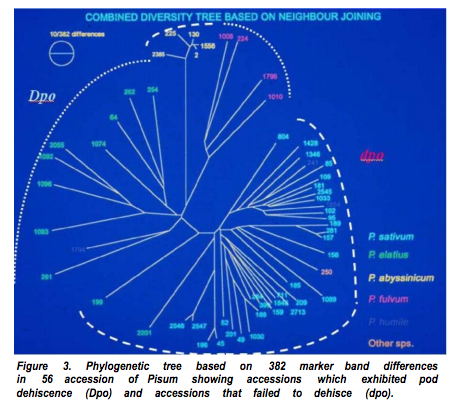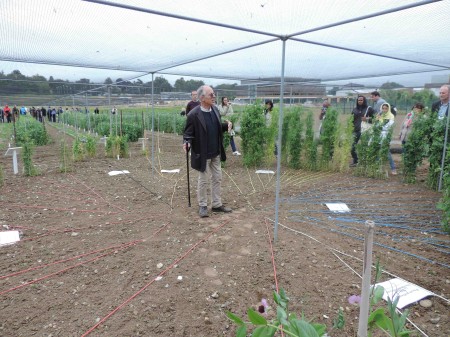- Geopolitical Maize: Peasant Seeds, Everyday Practices, and Food Security in Mexico. Growing landraces in Mexico as a feminist act.
- Resource-Use Patterns in Swidden Farming Communities: Implications for the Resilience of Cassava Diversity. In this bit of Brazil, all farmers have some cassava varieties, other varieties are more private, which means that diversity is reasonably well maintained if farms are lost at random. Ah, but what about if women farmers are lost?
- Indigenous Knowledge on Landraces and Fonio-Based Food in Benin. 35 landraces, some of them even agronomically good. No word on whether those are the common or the private ones.
- A Review on Genetic Improvement of Cauliflower. There’s a tension between hybrids and breeding for organic conditions even in cauliflower.
- Growth Performance of Indian Major Carps and Their Hybrids in Polyculture in Bangladesh. Looks like hybrids are bad in carp, though.
- Deep Evolutionary Comparison of Gene Expression Identifies Parallel Recruitment of Trans-Factors in Two Independent Origins of C4 Photosynthesis. Plants which diverged 140 million years ago have in the meantime evolved the same trans-factors (“protein that binds to specific DNA sequences, thereby controlling the flow [or transcription] of genetic information from DNA to messenger RNA”) to come up with C4 photosynthesis. You know, this C4 rice thing just might be doable.
- Organic Diets Significantly Lower Children’s Dietary Exposure to Organophosphorus Pesticides. When “conventional” food was replaced by organically grown stuff, children had lower levels of nasties in the urine. No word on what it took to convince the kids to eat their veggies.
- Building the crops of tomorrow: advantages of symbiont-based approaches to improving abiotic stress tolerance. Why breed, when you can inoculate.
- A single evolutionary innovation drives the deep evolution of symbiotic N2-fixation in angiosperms. It all started long ago with a cryptic mutation, which was lost and gained multiple times, but some clades are unlikely to lose it when they have gained it.
- Seeds of Persistence: Agrobiodiversity in the American Mountain South. “…southern/central Appalachia is the most diverse foodshed at the varietal level in the United States, Canada, and northern Mexico studied to date.”
- Separating the wheat from the chaff – a strategy to utilize plant genetic resources from ex situ genebanks. Using fancy math to mine legacy phenotypic data can yield a couple extra alleles.
- Sustainability and Food & Nutrition Security: A Vulnerability Assessment Framework for the Mediterranean Region. Take each vulnerability (say to climate change, or price volatility) and break it down into exposure, sensitivity and adaptive capacity.
Brainfood: Old flax, Rice in Spain, Rice in Iran, Mozambican cowpea, Agrobiodiversity reserve, Old olives, Georgian livestock, Crowdsourcing fungi
- Harvesting wild flax in the Galilee, Israel and extracting fibers — bearing on Near Eastern plant domestication. The wild stuff was harvested before the Neolithic Revolution.
- Building resilience to water scarcity in southern Spain: a case study of rice farming in Doñana protected wetlands. Better to restore part of the rice fields to natural wetlands.
- Evaluation of rice dominance and its impact on crop diversity in north of Iran. Rice can’t catch a break in Iran either.
- Evaluation of four Mozambican cowpea landraces for drought tolerance. One of them is promising.
- Agro-Biodiversity Spatial Assessment and Genetic Reserve Delineation for the Pollino National Park (Italy). Somewhat gratuitous use of GIS, as far as I can see, but pretty maps.
- A comparative analysis of genetic variation in rootstocks and scions of old olive trees — a window into the history of olive cultivation practices and past genetic variation. Much more variation among rootstocks than scions.
- The diversity of local Georgian agricultural animals. I’d like to see a Megrelian horse one day, they sound cool.
- Crowdsourcing to create national repositories of microbial genetic resources: fungi as a model. Why just fungi, though?
Pisum phylogeny illustrated in really cool way
Yeah, sure, you can publish your Pisum phylogenetic tree the usual way:
But isn’t it a whole lot better to do it like this?
That’s the author, Mike Ambrose of the John Innes Centre Germplasm Resources Unit showing off his handiwork. Thanks to Nora Castañeda for the photo. It’s all happening because of the PGRSecure conference in Cambridge, UK. which you can follow on Twitter.
LATER: And thanks to Jim Croft for pointing out something similar from Down Under.
Brainfood: Open sesame, Turkish buffalo, Crops & diets, Tuberous-rooted chervil, Pine breeding, Pigeonpea diversity, Sorghum adoption, Slumdog trees, Regenerating wild sunflower
- Sesame Crop: An Underexploited Oilseed Holds Tremendous Potential for Enhanced Food Value. Nice overview of diversity conservation and use. Lots of scope for improvement.
- Microsatellite based genetic diversity among the three water buffalo (Bubalus bubalis) populations in Turkey. No great evidence of differentiation among populations into breeds, unlike in India, say.
- Crop diversification, dietary diversity and agricultural income: empirical evidence from eight developing countries. More crops grown, more dietary diversity.
- Temporal evolution of the genetic diversity of Chaerophyllum bulbosum: Consequences on the genetic resources management. French article on the lack of hydrographic structuring, or erosion, in the genetic diversity of largely forgotten apiaceous root vegetable in Germany.
- Merging applied gene conservation activities with advanced generation breeding initiatives: a case study of Pinus radiata D. Don. Because introduction of new diversity from native areas is difficult, foresters in non-native areas should better understand and use the diversity in existing provenance/progeny trials.
- Comparative Analysis of Genetic Diversity among Cultivated Pigeonpea (Cajanus cajan (L) Millsp.) and Its Wild Relatives (C. albicans and C. lineatus) Using Randomly Amplified Polymorphic DNA (RAPD) and Inter Simple Sequence Repeat (ISSR Fingerprinting. 16 Indian accessions classified in 3 clusters, with the stress resistant material mostly together. More diversity in the wilds.
- The role of varietal attributes on adoption of improved seed varieties: the case of sorghum in Kenya. Not just about yield.
- Vegetation in Bangalore’s Slums: Boosting Livelihoods, Well-Being and Social Capital. What’s needed is trees with short stature, narrow trunks, medium canopy, high value. How many species like that can you think of?
- Comparison of fatty acid composition of oil from original and regenerated populations of wild Helianthus species. It’s not the same.
Nibbles: Colombian chocolate, Urban ag, Subaks, GM debate, Taxonomy online, Genebank tools online, BBC on Kew, Australian seed bank, Cedar of Lebanon, Pizza philosophy, Feijoada
- Move over Juan Valdez. Cacao farmers want to emulate a marketing icon.
- Urban agriculture not all it’s cracked up to be. Living up to that urban ag icon, Cuba, is hard.
- Bali’s iconic, traditional subaks are a complex adaptive system, and much better than modern rice farming alternatives. Makes you wonder why they need protecting, though.
- GM bananas will save us. Not by themselves they wont. I don’t know why I keep linking to this stuff. Nothing at all iconic about it.
- Iconic taxonomic revision tools online.
- Something else that’s online is a bunch of tools for analyzing genebank data. Soon to be iconic, no doubt. As soon as people use them. So get cracking.
- Huge BBC documentary on Kew coming up. I bet the iconic Millennium Seed Bank will feature.
- Speaking of iconic genebank buildings, today’s one comes from Australia.
- The history of an iconic Middle Easter tree?
- The philosophy of an iconic Italian delicacy. Well, Neapolitan, really.
- And in honour of the World Cup (I refuse to put FIFA in front, let them sue me), an iconic Brazilian dish. And don’t worry, those beans are safe. Somewhere iconic.

